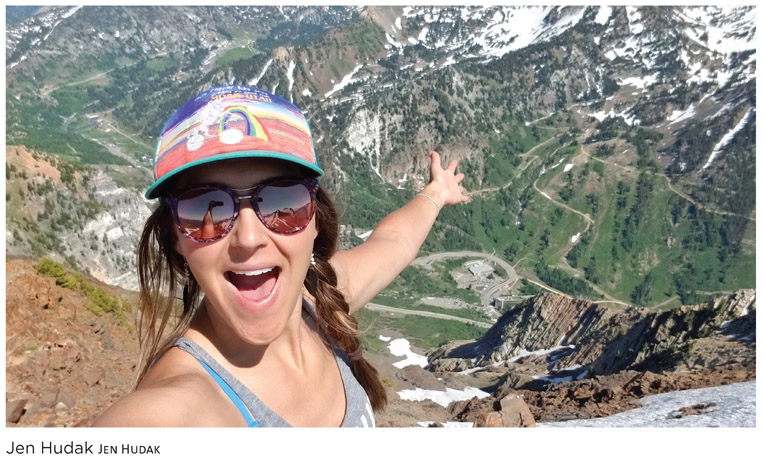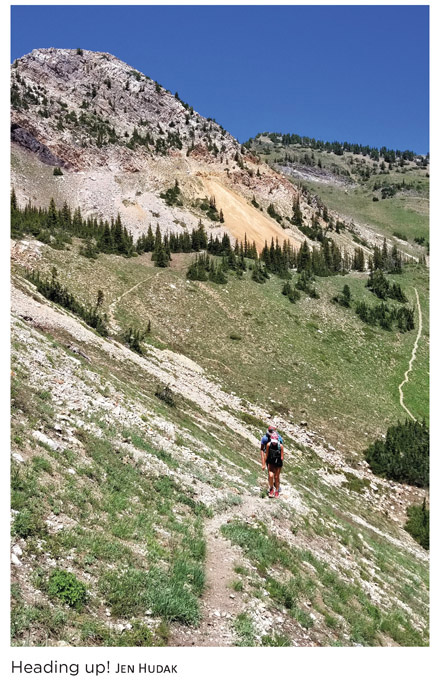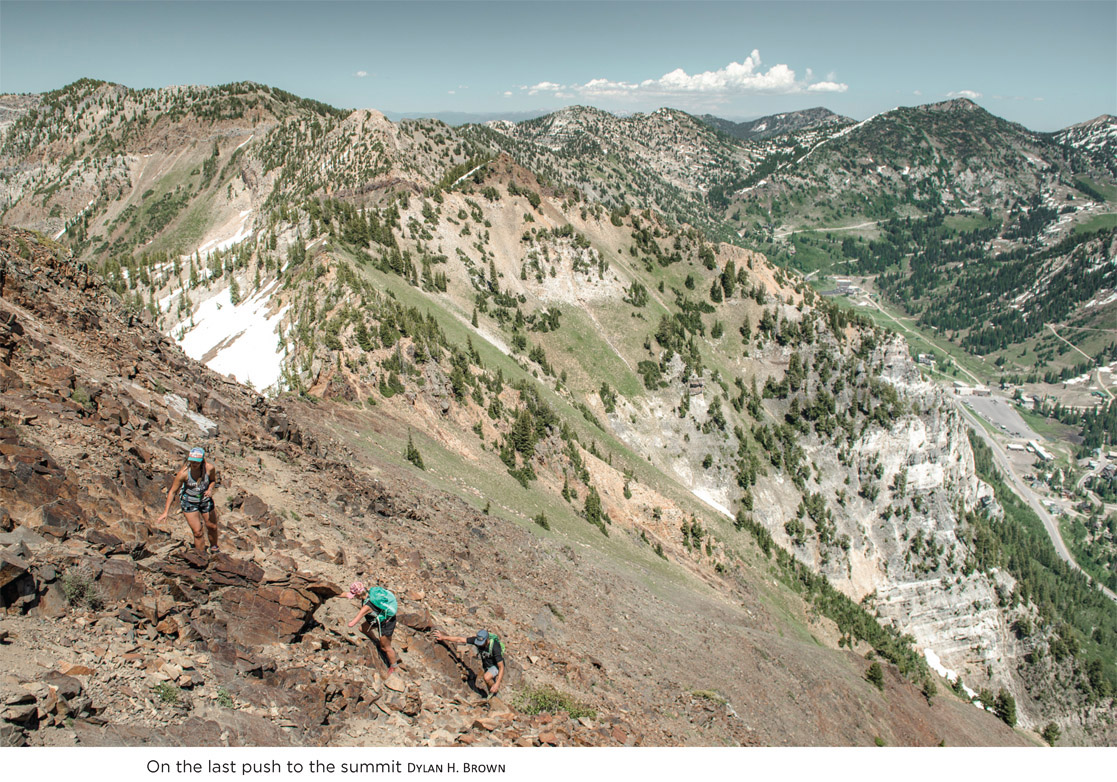
To many, Jen Hudak is one of the greatest female halfpipe skiers of all time. Born and raised in Connecticut, Jen had perseverance and adventure in her blood from the early days, when her father constructed a makeshift rope-tow system so she could ski in their backyard. Her skills progressed, as did her love for halfpipe. Then, in 2004, she found herself standing on her first (of many) podiums at the US Freeskiing Open. From there, she won every professional competition possible: the US Open, World Ski Invitational, Dew Tour, US Nationals, and the X Games. In fact, she racked up two gold medals in the 2010 X Games alone, with a grand total of five overall X Games medals. But Jen had set her sights on something even bigger: the Olympics.

Jen strongly believed that halfpipe skiing would make its way to the Olympic stage, and she worked hard to get it there. In fact, many directly credit its debut at the 2014 Sochi Olympics to Jen and all of her efforts over the years. Her dream was to participate in those Olympics, but unfortunately she tore her knee in December 2013 at the qualifier, ending her chances and concluding her ski career.
Today, Jen is a competitive mountain biker, life coach, and writer. She and fellow American freeskier Kristi Leskinen competed on season 30 of The Amazing Race, becoming the first team to finish in the top 3 for all 12 legs and finishing with the highest average for any female team in the history of the TV show.
If you are looking to stand atop a classic Wasatch Range peak, look no further. Mount Superior (along with nearby Monte Cristo Peak) towers over Little Cottonwood Canyon and fills the skyline when viewed from nearby Alta Ski Area or Snowbird Resort. This hike is a great way to push your fitness and challenge yourself while tackling steep slopes and somewhat-exposed scrambling near the top. But it is still close to Salt Lake City, so you can return home in time for dinner. Bonus: Hit up Mount Superior in the winter and you’ll find yourself a classic ski line.
Nearest Town: Sandy, Utah
Getting There: From Sandy, catch UT 209 E/Little Cottonwood Road until it connects with UT 210 E. Take a right and drive 8.1 miles up the canyon to the police station and town office.
Trailhead: Alta Sheriff’s Office GPS: N40 35.581', W111 38.198'
Fees and Permits: None
Trail Users: Hikers, trail runners
Elevation Gain: 2,768 feet
Length: 5.4 miles RT (out-and-back)
Approximate Hiking Time: Half Day–Full Day
Difficulty: Moderate–Advanced
Insider Info: Monte Cristo and Mt. Superior are smack next to each other, but there is some debate over which peak is which. USGS Maps lists the higher summit (11,132 feet) as Mt. Superior, but locals prefer to call the higher peak Monte Cristo and the lower peak Mt. Superior. These directions take you to the first peak, here referred to as Mt. Superior. Regardless, tacking on the additional 15-minute hike from the summit of Mt. Superior over to Monte Cristo is well worth the extra effort.
Managing Agency: Uinta-Wasatch-Cache National Forest
It was one of those perfect July days in the Wasatch. A bluebird sky filled the horizon, offset by a couple of practically perfect puffy clouds that more closely resembled cotton balls than actual meteorological features. Wildflowers dotted the hillside as cheery indicators of the long days and warm temperatures, their petal-surrounded faces opening and shutting with the dawning and closing of each day. Summer weather is simply made for hiking, and quite a few outdoorists from Salt Lake agreed. Groups of two and three people wearing colorful clothing could be seen scattered up and down the trail, each person huffing and puffing as they tackled the steep terrain that led up to the looming Mount Superior. Jen Hudak was one of these hikers.

This was not the first time Jen had stood atop Mount Superior. In fact, she can barely remember the first time she experienced the magnificent 360-degree views from the summit since she has been up and down the peak so many times. That’s what happens when such an iconic trail is minutes from your doorstep. But this warm summer day was memorable in itself: Jen was hiking Mount Superior.
For a world-class halfpipe competitor like Jen, life revolved around two things: snow and skis. She literally and figuratively grew up on skis, turning professional when she was merely a teenager. Instead of weekends at the mall, Jen stood atop podium after podium, winning various freeskiing competitions. This in itself is telling of her work ethic since there is nothing natural about the sport of halfpipe. Athletes ski down the pipe, launching various tricks and skills off the walls while soaring through the air, before landing and doing it all over again. This type of body control and amplitude calls for intense athleticism and nerves of steel due to the inherent risk in the sport; Jen has both. She is naturally gifted and a hard worker; a deadly combo that is tough to beat. But this also meant that everything in life redirected back to skiing. So yes, Jen stood on the summit of Mount Superior many times prior to this vivid July morning, but she always arrived there via skis.
In 2013, Freeskier magazine published an article entitled, “Ten Hottest Women in Freeskiing,” highlighting female athletes based on their physical appearance rather than their skiing abilities. Jen directly tackled the problem via a blog post on her website. In “Sex and the Female Athlete,” Jen discussed the difficulties female athletes face in an industry focused on their appearances rather than their capabilities. In her article, Jen discussed a Freeskier photo shoot she participated in when she was a 17-year-old up-and-comer on the scene. Instead of highlighting her insane amplitude in the halfpipe, the magazine asked her to pose in a bubble bath. As a young athlete, Jen knew exposure was critical at this stage in her career and enjoyed the shoot, but the adult Jen looks back and questions what image she perpetuated.
This wasn’t the first time Jen was at the forefront for women’s rights in the skiing world. In fact, she fought this battle throughout her professional career. She frequently spoke out against the media coverage of female sports. At the time, 95 percent of on-air time was dedicated to men’s sports, and the Dew Tour only showed a highlight reel for the female events versus live on-air coverage for the men’s events. Jen vocally supported the X Games since it was one of the few competitions that awarded equal prize money to men and women. Among other reasons, this was why Jen pushed so strongly for halfpipe skiing to be included in the Olympics. Paving the way for future female athletes to compete on the world stage alongside men was a dream come true for Jen, and she continues to be grateful that she played such an integral part in the fruition of that dream.
Trekking the peak was so very different than skiing. Coming off her ninth knee surgery (three on her left knee, six on her right), Jen always viewed hiking as a means to an end—it was a great second-choice alternative to skiing thanks to the athletic benefits. Since hiking is such a low-impact sport, surgeons highly recommend the activity post-op to increase fitness and muscle tone without the fear of further damaging joints or ligaments. But for an athlete who routinely landed halfpipe tricks that sent her soaring upwards of 30 feet off the ground, keeping both feet close to terra firma while slowly trekking up a mountain seemed a bit mundane. Until it didn’t.
Hiking Mount Superior in July was the first time Jen accepted her body’s limitations with grace. She wasn’t hiking the trail as a means to anything; in fact, it was the opposite. She wanted to be outside in nature and could think of no better way to enjoy the morning than by hiking the Wasatch’s finest with a few good friends. As she steadily worked her way up the mountain, she acknowledged the second change of the day: her hiking poles. Previously, her ego hadn’t allowed her to succumb to such a “goofy” addition to her gear kit. But with time comes maturity, and Jen realized she simply didn’t care anymore. While her pride still hated relying on the external carbon-fiber support system, she knew it was for the best. She wouldn’t be out on the trail with the warm sun reflecting off her face if it wasn’t for those very same walking sticks. Rather than dwell on it, she opted for positivity. Halfpipe skiing is notoriously dangerous and laden with physical consequences. After years of competition, Jen’s body had been through a lot, so now was the time to respect and honor all it had accomplished for her.

She continued upward, hiking through the wildflowers and eventually attaining Cardiff Pass. From there, she scrambled her way westward, along the ridge and up and over a few knobs until she was standing on top of Mount Superior with the entirety of Little Cottonwood Canyon spread out beneath her. It was an entirely different experience challenging the peak on foot rather than skis, but in a way it represented the passing of a torch and the dawning of a new era in her life. For years, Jen was the face of halfpipe skiing, a moniker she decidedly deserved. But now, with her competitive skiing days behind her, the future is still approaching, bright and shiny like a copper penny and full of glittering opportunity. Instead of X-Games podiums she now focuses on helping other professional athletes transition their career paths. Rather than practice a new half-pipe skill she instead engages in public speaking to help others learn how to harness the power of visualization. These days life is full of changes for Jen, and this hike is merely the beginning of what is yet to come. She better hang onto those trekking poles.
Begin by walking up the paved road next to Our Lady of the Snows Center, and take your first right. Walk by the Sheriff’s Station; the road will curve west as it turns into dirt. Continue to follow the power lines as the road turns back east. Very shortly, the trail splits with an old mining road that forks to the left; take this fork. Work your way up the switchbacks, ignoring all the social trails. Instead, stay on the old mining road. About two-thirds of the way through your hike, you will see an obvious fork; stay to the left. After this split, hike through a meadow and continue upward as the trail grows very steep until you reach Cardiff Pass, aptly known as Telephone Pole Pass thanks to the prominent telephone pole and wires that can be found on the pass. Once here, hang a left (west) and follow the electrical line up the talus-covered ridge. The trail is very steep here in sections, but they are brief. The real scrambling is still to come! Continue to follow the defined path up the ridge as it turns to steep and loose dirt surrounded by talus. This section is not well defined and scrambling will be required, but aim to stay high so you do not lose any of your hard-earned elevation. You will know you’ve reached the summit when you spot the mailbox with a notebook and pen inside. Don’t forget to leave a note!
0.0 Begin walking up the paved road next to Our Lady of the Snows Center.
0.1 Take a right as you pass the Sheriff’s Station on your left.
0.2 The trail will split; take the mining road to the left and begin climbing.
0.8 You will come to an obvious split in the trail; stay to the left.
1.4 You’ve reached Cardiff Pass and climbed over 1,300 feet; take a left and hike westward along the ridge.
1.9 The trail grows very steep here and may call for scrambling in sections.
2.6 This is the final push to Mount Superior.
2.7 You’ve reached the summit; return to the car on the same trail.